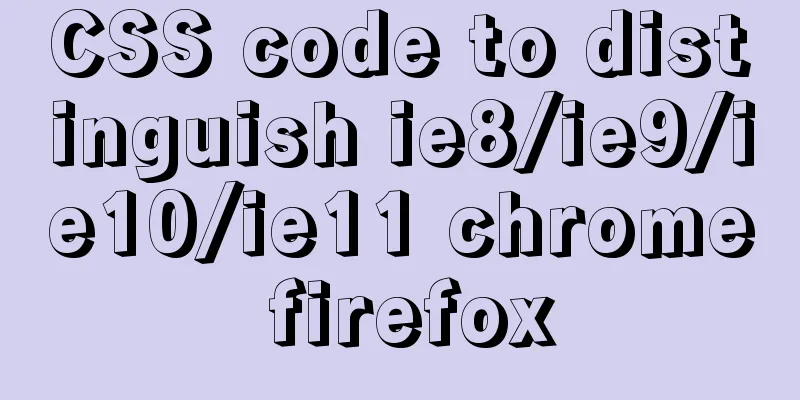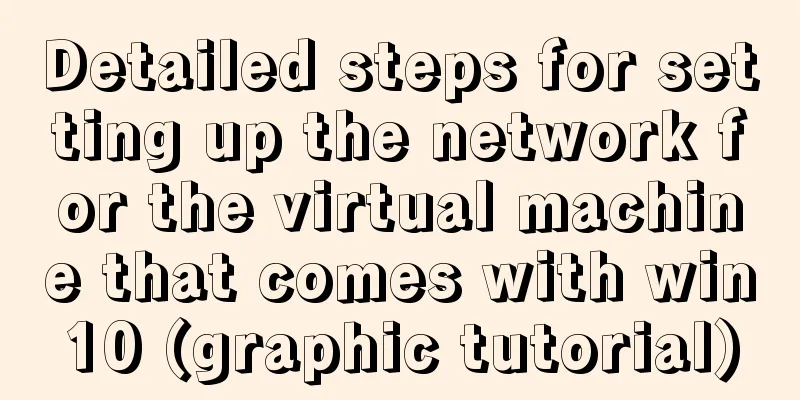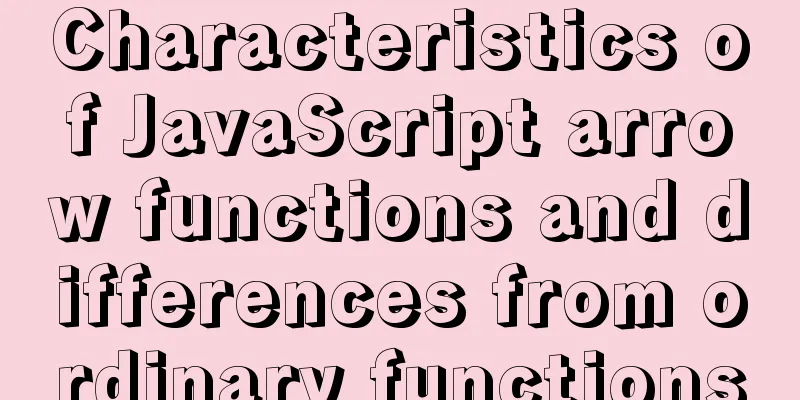Detailed explanation of Vue's front-end system and front-end and back-end separation

OverviewVue (pronounced /viu/, similar to view) is a progressive framework for building user interfaces, released in February 2014. Unlike other large frameworks, Vue is designed to be applied layer by layer from the bottom up. Vue's core library only focuses on the view layer, which is not only easy to get started, but also easy to integrate with third-party libraries (such as: Official website: https://cn.vuejs.org/v2/guide/ Front-end knowledge systemThere is still a long way to go to become a true "Internet Java full-stack engineer", among which "I am a big front-end" is a compulsory course that cannot be avoided. The main purpose of this stage of the course is to lead my Java backend programmers to recognize, understand, and master the front end, so as to take another step forward in becoming an "Internet Java full-stack programmer." Three elements of the front end
Presentation layer (CSS)CSS is a markup language, not a programming language, so you cannot customize variables or reference them. In other words, it does not have any syntax support. Its main flaws are as follows:
This has resulted in a lot of unnecessary extra work for us. To solve this problem, front-end developers use a tool called a CSS preprocessor to provide a style layer reuse mechanism that is missing from CSS, reduce redundant code, and improve the maintainability of style code. Greatly improves the front-end development efficiency in terms of style. What is a CSS preprocessor? CSS preprocessor defines a new language. The basic idea is to use a special programming language to add some programming features to CSS, use CSS as the target to generate files, and then developers only need to use this language to do CSS coding. To put it in layman's terms, it means " using a specialized programming language to design the web page style, and then converting it into a normal CSS file through a compiler for use in the project." What are the commonly used CSS preprocessors?
Behavior layer (JavaScript)JavaScript is a weakly typed scripting language. Its source code does not need to be compiled before being sent to the client for execution. Instead, the character codes in text format are sent to the browser for interpretation and execution. Native JS development Native JS development means that we develop according to the **[ECMAScript]** standard, abbreviated as ES, and its feature is that all browsers support it. As of the time of this blog post, the ES standard has released the following versions:
The difference is the gradual addition of new features. TypeScript Microsoft Standard TypeScript is a free and open source programming language developed by Microsoft. It is a superset of JavaScript and essentially adds optional static typing and class-based object-oriented programming to the language. Led by Anders Hejlsberg (father of C#, Delphi, TypeScript; founder of .NET). The characteristic of this language is that in addition to the features of ES, it also incorporates many new features that are not within the scope of the standard, so many browsers cannot directly support TypeScript syntax and need to be compiled (compiled into JS) before they can be correctly executed by the browser. JavaScript Frameworks
UI Framework
JavaScript build tools
Three-terminal unificationHybrid AppThe main purpose is to unify three terminals (PC, Android: .apk, iOs: ipa) and be able to call the underlying hardware of the device (such as sensors, GPS, cameras, etc.). There are two main packaging methods:
WeChat Mini ProgramFor details, please refer to the WeChat official website. Here is a framework that facilitates the development of WeChat applet UI: WeUl Backend Technology In order to facilitate development, front-end personnel also need to master certain back-end technologies, but our Java back-end personnel know that the back-end knowledge system is extremely large and complex, so in order to facilitate front-end personnel to develop back-end applications, technologies such as NodeJS have emerged. The author of NodeJS has announced that he will give up NodeJS (the poor architecture and the cumbersome node_modules may have made the author unhappy), and started to develop Deno, a new architecture. Since it is a backend technology, it definitely requires a framework and project management tools. The NodeJS framework and project management tools are as follows:
Mainstream front-end frameworksVue.js iView iview is a powerful Vue-based UI library with many practical basic components that are richer than elementui components. It mainly serves the mid- and back-end products of PC interfaces. Use the single-file Vue component development model based on npm + webpack + babel development, support ES2015 high-quality, feature-rich and friendly API, and use space freely and flexibly.
Note: It is a mainstream front-end framework and can be considered when selecting. Its main feature is that it supports more mobile terminals. ElementUlElement is a Vue Ul component library maintained by Ele.me's front-end open source. It has a complete set of components, basically covering all the components required for the backend. The documentation is detailed and the examples are rich. It is mainly used to develop PC pages and is a high-quality Vue Ul component library. Note: It is a mainstream front-end framework and can be considered when selecting. Its main feature is that it supports more desktop terminals. ICEFeibing is the Alibaba team's mid- and back-end application solution based on React/Angular/Vue. Within Alibaba, more than 270 projects from almost all BUs are using it. Feibing includes a complete link from the design end to the development end, helping users to quickly build their own mid- and back-end applications. Note: The main components are still based on React VantUlVant Ul is a Vue component library implemented by Youzan's front-end team based on Youzan's unified specifications, providing a complete set of Ul basic components and business components. With Vant, you can quickly build pages with a unified style and improve development efficiency. Utat-ui is a front-end UI component library based on Vue 2.x, mainly used for rapid development of PC website products. It provides a set of npm + webpack + babel front-end development workflows, with independent CSS styles, and can maintain a unified UI style even if different frameworks are used. CubeUlcube-ui is a sophisticated mobile component library developed by the Didi team based on Vue.js. Supports on-demand introduction and post-compilation, lightweight and flexible: strong scalability, can easily achieve secondary development based on existing components. Wait for the UI… Front-end development historyThe MVC era dominated by the backend
advantage MVC is a very good collaboration model that can effectively reduce the coupling of code and allow developers to understand where the code should be written from an architectural perspective. In order to make the View more pure, you can also use template engines such as Thymeleaf and Freemarker to prevent Java code from being written into the template, making the division of labor between the front-end and back-end clearer. shortcoming
In this way, as long as the front end is a little weak, the back end will often require it to write a lot of business code in the template layer. There is also a big gray The zone is the Controller, and functions such as page routing should be the most concerned by the front-end, but they are implemented by the back-end. The Controller itself is often entangled with the Model, and the business code that makes people grit their teeth will appear in the Controller layer. These problems cannot be attributed entirely to the programmer's quality, otherwise JSP would be enough.
The SPA era brought by AJAX Back in 2005, AJAX (Asynchronous JavaScript And XML) was officially proposed and CDN was used as static resource storage, which led to the return of JavaScript. (Before that, JS was used to post dog-skin plaster ads on web pages) The SPA (Single Page Application) era.
advantage In this mode, the division of labor between the front-end and back-end is very clear, and the key collaboration point between the front-end and back-end is the AJAX interface. It looks so wonderful, but looking back, it is not much different from the JSP era. The complexity has moved from the JSP on the server to the JavaScript on the browser, making the browser side very complex. Similar to Spring MVC, a layered architecture for browsers began to emerge in this era:
shortcoming
The MV* mode here is as follows:
In order to reduce the complexity of front-end development, a large number of front-end frameworks have emerged, such as
advantage
shortcoming
The full-stack era brought by NodeJSThe MV* model, which focuses on the front part, solves many problems, but as mentioned above, it still has many shortcomings. With the rise of NodeJS, JavaScript has the ability to run on servers. This means there is a new model for R&D:
In this R&D model, the responsibilities of the front-end and back-end are very clear. For the front end, the two UI layers have their own responsibilities:
Through Node, the Web Server layer is also JavaScript code, which means that some codes can be reused before and after. Scenarios that require SEO can be rendered synchronously on the server side, and performance issues caused by too many asynchronous requests can also be alleviated through the server side. The shortcomings of the previous model can almost be perfectly solved by this model. Compared with the JSP model, the full-stack model seems to be a regression, and it is indeed a regression to the original development model, but it is a spiral regression. The full-stack model based on NodeJS still faces many challenges:
SummarizeThis article ends here. I hope it can be helpful to you. I also hope that you can pay more attention to more content on 123WORDPRESS.COM! You may also be interested in:
|
<<: Mysql SQL statement operation to add or modify primary key
>>: New ways to play with CSS fonts: implementation of colored fonts
Recommend
JavaScript canvas Tetris game
Tetris is a very classic little game, and I also ...
Mysql database design three paradigm examples analysis
Three Paradigms 1NF: Fields are inseparable; 2NF:...
Native js implementation of slider interval component
This article example shares the specific code of ...
Detailed explanation of the use of the built-in function locate instr position find_in_set in MySQL efficient fuzzy search
There are 4 commonly used methods, as follows: 1....
A brief analysis of how to access Windows 10 host folders from CentOS 8 virtual machines
After installing VMware Tools, ① text can be copi...
How to reduce image size using Docker multi-stage build
This article describes how to use Docker's mu...
Detailed tutorial for installing mysql5.7.21 under Windows system
MySQL Installer provides an easy-to-use, wizard-b...
Analysis of Linux kernel scheduler source code initialization
Table of contents 1. Introduction 2. Basic Concep...
Implementation of Bootstrap web page layout grid
Table of contents 1. How the Bootstrap grid syste...
4 ways to optimize MySQL queries for millions of data
Table of contents 1. The reason why the limit is ...
Correct use of Vue function anti-shake and throttling
Preface 1. Debounce: After a high-frequency event...
Corporate website and column dictionary Chinese and English comparison Friends who make Chinese and English bilingual corporate websites need
name character name character information news te...
MySQL 5.7.20 common download, installation and configuration methods and simple operation skills (decompression version free installation)
I just finished installing MySQL 5.7.19 in the ea...
Summary and analysis of commonly used Docker commands and examples
Table of contents 1. Container lifecycle manageme...
JavaScript to achieve stair rolling special effects (jQuery implementation)
I believe everyone has used JD. There is a very c...















